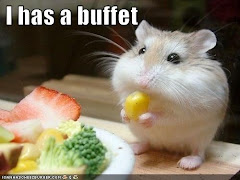 Dwarf Winter White Russian
Dwarf Winter White Russian Dwarf Russian
Dwarf RussianThe Russian Dwarf Hamster is a term that usually refers to several different types as well as the Winter White Russian Dwarf hamster, Campbell's Russian Dwarf hamster, and Roborovski's Dwarf hamster. The Russian Winter White's and Campbell's Russian dwarf hamsters could also be mistaken for just one breed due to their similar size of around 8 to 10 centimeters and their coloring. The Roborovski hamster is normally the smallest of these three hamsters and it normally only grows to around 4 to 5 centimeters.
Winter White dwarf hamsters can be a lot rarer than the Campbell's dwarf hamster at local pet stores. They are normally sold in pairs of the same sex and are very friendly. What is also so incredible about these little critters is their ability to change their color in the winter months. In their native home environment, Winter Whites (incredibly) change from their normal dark grey coloring to white in order to camouflage themselves and escape from predators in the snow. It is an ability that has even followed them even into captivity today. The process of their color change has to do with the amount of natural sunlight they receive on a daily basis. The shorter the hours of day light the quicker is their change to white. Winter Whites that are exposed to mainly artificial light will most probably not change their color.
Campbell's Russian dwarf hamsters can also be known as Djungaria hamsters because they originate from the region in Mongolia called Djungaria. This it the type of dwarf hamsters that are most commonly found in your local pet stores. The growth of their popularity was equally matched by the growth of creative breeding and also lent itself to an increase in many variations of their color combinations and markings. As well as their natural or normal wild color, those wanting to obtain these hamsters can also find them with spots, mottled, or even warmer colors like cinnamon, black or even shades or blue or lilac.
Roboroski dwarf hamsters can often be found in their normal habitats in the desert dunes of Western and Eastern regions of Mongoilia and even in some parts of Northern China. Being slightly smaller then their White Winter and Campbell's dwarf hamster nephews, they have slightly longer legs. Their coat is normally sandy brown in color that has a slate grey undercoat. Because of their high energy levels, they can sometimes be a little bit harder to keep as pets and it is worth noting that they are too small for most wire cages. The majority of these small critters can squeeze themselves through the bars. One of the good traits ot the Roboroski hamster is that it is an extremely clean animal. Most of its time is spent grooming itself and they also love a nice dust bath.
Besides the fact that there are many kinds of Russian Dwarf Hamsters, they all require about the same amount of care. Another point to remember is that dwarf hamsters can be very fast to escape ,so it can be an advantage to give them a little more time and exercise outside of the cage with the use a small hamster ball. These balls are especially made so that the hamster can run around your floor without getting lost. It might be worth pointing out that (as a word of caution), don't let them play too close too stairways.
Winter White Russian hamsters are a species of Hamster in the genus Phodopus. They are typically half the size of the better-known Syrian hamster, and therefore called dwarf hamsters along with all Phodopus species. Features include a typically thick dark grey dorsal stripe and furry feet. The tail is so short that it hardly shows when the hamster is sitting. As winter approaches and the days shorten, Winter Whites' dark fur is moulted and replaced with a coat which is almost completely white (hence the name). In the wild, this adaptation helps them evade predators in the snow-covered steppes of winter. They live mainly in Siberia and are also found in Dzungaria, Kazakhstan, Mongolia and Manchuria.
It has been debated whether the Winter White hamster was a sub-species of the Campbell's Dwarf Hamster (Phodopus campbelli) or not; however, recently it was decided that Winter Whites are of their own species, Phodopus sungorus.
The average lifespan of the Winter White Russian Dwarf Hamster is 1½ to 2 years, although they can live longer.Winter Whites are often found on the pet market, in Japan and Europe more so than in North America and indeed are rarely found in pet stores in Canada. Care is similar to that of the Campbell's Dwarf Hamster. Winter White hamsters make good pets for teens or adults, not for younger children. They are usually more friendly to humans than other hamsters, and are less likely to bite. Due to a hamsters poor eyesight the risk of falling or jumping off your hand is high. Compared to other dwarf hamsters, they are also more agressive and territorial to their cage mates. Winter White hamsters which could have some Campbells ancestry should not be fed food containing sources of monosaccharides because of the risk of developing diabetes mellitus[2].

